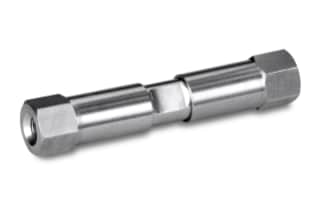
|
Chemistry |
C18 |
|
Separation Mode |
Reversed Phase |
|
Particle Substrate |
Silica |
|
pH Range Min |
2 pH |
|
pH Range Max |
8 pH |
|
Maximum Pressure |
6000 psi (415 Bar) |
|
Endcapped |
Yes |
|
Bonding Technology |
T3 |
|
Silanol Activity |
Medium |
|
Particle Shape |
Spherical |
|
Particle Size |
3 µm |
|
Endfitting Type |
Waters |
|
Pore Size |
100 Å |
|
Format |
Intelligent Speed (IS) Column |
|
Surface Area |
330 |
|
System |
HPLC |
|
USP Classification |
L1 |
|
Inner Diameter |
4.6 mm |
|
Length |
20 mm |
|
Carbon Load |
14 % |
|
UNSPSC |
41115709 |
|
Brand |
Atlantis |
|
Product Type |
Columns |
|
Units per Package |
1 pk |

Atlantis T3 Intelligent Speed (IS) Column, 100Å, 3 µm, 4.6 mm X 20 mm, 1/pk
Your first option when creating separations of polar and non-polar compounds should be Atlantis T3 columns, which are universal, silica-based, reversed-phase C18 columns that allow balanced retention of polar and hydrophobic molecules. A trifunctional C18 alkyl phase is used in the Atlantis T3 Column's innovative T3 bonding technique, which is bonded at a ligand density that encourages polar compound retention and compatibility with water mobile phases. When compared to the conventional trimethyl silane (TMS) end-capping, the patented T3 end-capping method is significantly more efficient. You get better polar compound retention and aqueous compatibility when the special end-capping and T3 bonding are combined.
As a superb alternative to traditional C18 reversed-phase LC columns, the Atlantis T3 Column offers greater performance over a wider pH range, good retention of, and selectivity for neutral, hydrophobic chemicals in addition to polar analytes. In addition to these unique features, the lab equipment offers better column lifetime, peak shape, and stability.
Use the Atlantis T3 column for straightforward retention and separation of polar compounds. This crucial piece of lab equipment is designed to provide better peak shapes for bases containing amines at pH 7, as well as longer lifetimes at low pH. As a result, you can count on the Atlantis T3 column to function superbly with the analytical column across a wide pH range. It is an all-purpose, silica-based reversed-phase C18 column that enables the retention and separation of highly polar compounds in a variety of applications. It is a wonderful alternative to traditional C18 reversed-phase LC columns because it offers exceptional retention and selectivity for neutral, hydrophobic compounds in addition to polar analytes.
With the right lab supplies, you can work more efficiently. When looking to shop for lab equipment, you can browse our website and refer to our catalog to replace your stock and increase your equipment portfolio. You may also be interested in Atlantis Silica T3 VanGuard Cartridge, 100Å, 3 µm, 3.9 mm X 5 mm, 3/pk; By eliminating particle pollution from the mobile phase stream, Atlantis T3 VanGuard Cartridges are utilized to increase analytical column lifetime and performance. All Atlantis T3 analytical columns with 3.9 mm and 4.6 mm I.D. and 3 m sorbent particles are protected by this cartridge.
What Does The Appearance of A Phenyl Group Look Like?
A phenyl group is composed of a hexagonal planar ring made of a cluster of six carbon atoms, five of which are connected to individual hydrogen atoms and the sixth to a substituent. In organic chemistry, phenyl groups are rather prevalent.